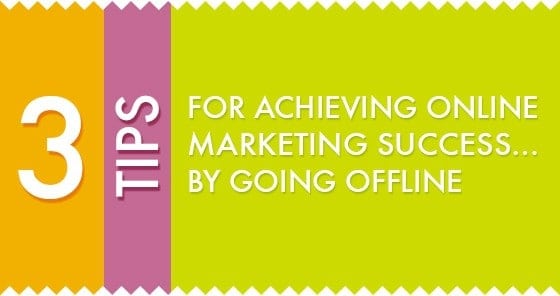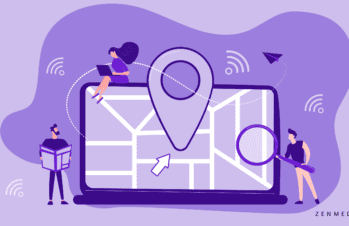In the world of online marketing, it’s easy to get caught up in the many purely virtual ways of reaching out to potential customers. There are so many ways of interacting with people online that never require any tangible connection with the real world. For instance: A company’s tweets point people to their blog, the blog gets them to sign up for emails, those emails promote a webinar, and that webinar convinces people to buy online… Never once do these interactions touch the offline world.
That’s definitely not a bad thing. Virtual, online marketing is beneficial to businesses and consumers alike, which is why both groups have embraced it wholeheartedly. And we’re pretty partial to it ourselves, here at Zen Media!
But precisely because it’s not as common to see an integration of online and offline marketing tactics, companies who do utilize offline methods to gain online success tend to stand out from the crowd.
There are myriad ways to use offline interactions with consumers to advance your online marketing, from the very simple (such as posting signs in your stores or offices to share your website and social media addresses with customers) to the more sophisticated (such as displaying a custom hashtag on the screen during a TV commercial to get people to engage). We’ve put together a list of three creative ideas to help get you started.
1. Speaking Engagements:
Any time that you or any of your employees is asked to speak at a seminar, conference, or convention – and especially if your company puts on an event itself – it’s a golden opportunity to merge your offline and online marketing efforts. There is an infinite number of ways to integrate social media into your talk.
A speaker can post a discussion question pertinent to his topic on Facebook or Google+, and then ask attendees to take out their smartphones and tablets and respond, right there during the talk.
The page in question can be displayed on the wall with a projector for all to see, as motivation to join in the discussion, and the speaker can reference specific people’s comments while speaking, even asking them by name to wave from their seat or continue their thoughts out loud.
The speaker could also post a few of the most important takeaways on social media, and invite attendees to submit follow-up questions on Facebook or Google+ in real-time, to be read off easily by the presenter, rather than shouting them across an auditorium.
Rather than handing attendees slips of paper to rate the presentation, speakers can ask them to like the company Facebook page as a sign that they approved, or even to comment positively in response to a posted question such as “Did you find today’s discussion of ____ to be helpful?”
Speakers can encourage attendees to sign up for their company’s email newsletter, incentivizing their subscription by offering either notes summarizing the talk, the PowerPoint presentation used, a workbook to put into practice what was discussed, or even a secret bonus ebook or white paper exclusively for those who attended.
And they shouldn’t expect their audience to sign up on their own, but rather, walk them through the process while they’re still in their seats, to ensure maximum participation.
Whenever possible throughout a presentation, get attendees liking, commenting, tweeting, following, and subscribing – in other words, engaging. While they are still in your audience, they are much more likely to engage than they would be if you simply told them to do it afterward. That real-world, in-person connection makes a big difference.
2. Offline Content:
There’s nothing that a company’s online audience loves to see more than a behind-the-scenes look at the inner workings of that business. Whether it’s the silly antics of employees, a sneak peek at a product in development, or a few words from the CEO, consumers love to feel connected to the real people behind a business.
It may take a few extra minutes each day, but it’s worth it for the heightened online engagement it will produce to capture and then publish offline content on a regular basis. Take pictures of employees working or goofing off, eating lunch or in training. Post them on Facebook or Instagram, asking for captions, or providing your own funny ones.
Post pictures of new job sites or new products, or short videos of the same. Even better, create short videos of various employees talking about their work – or make one yourself as CEO. Heartfelt explanations of a company’s mission, teasers for new projects in the works, and humorous pranks or good-natured jokes are all wildly popular online. Bringing some real-world experience of your company to your online audience will significantly boost their sense of connectedness with you.
3. Instruction Sheets:
Whenever anyone from your company interacts with a customer in person, in the real world, they should give that customer an instruction sheet asking them to go online and do whatever it is you’d like them to there, whether that’s signing up for your emails, liking you on Facebook, following you on Twitter, leaving positive feedback for you on a review site, or any other goal you have.
Left to their own devices, customers just aren’t as likely to post a positive review or like a company online after a good experience as they are to post a negative review after a bad one.
By asking them to give a testimonial or even just to do something as simple as liking your Facebook page, and then handing them easy-to-follow instructions for exactly how to do that, they’ll be much more likely to comply than if you never mentioned it.
These three ideas are really just the tip of the iceberg. Any time you can come up with a way to integrate your real-world, offline business activities with your online marketing, it will produce better results in both areas, and help you to stand out from the crowd.
Do you have any other suggestions for or experience with going offline to create online success? We’d love to hear them! Please share them with us in the comments section below.









